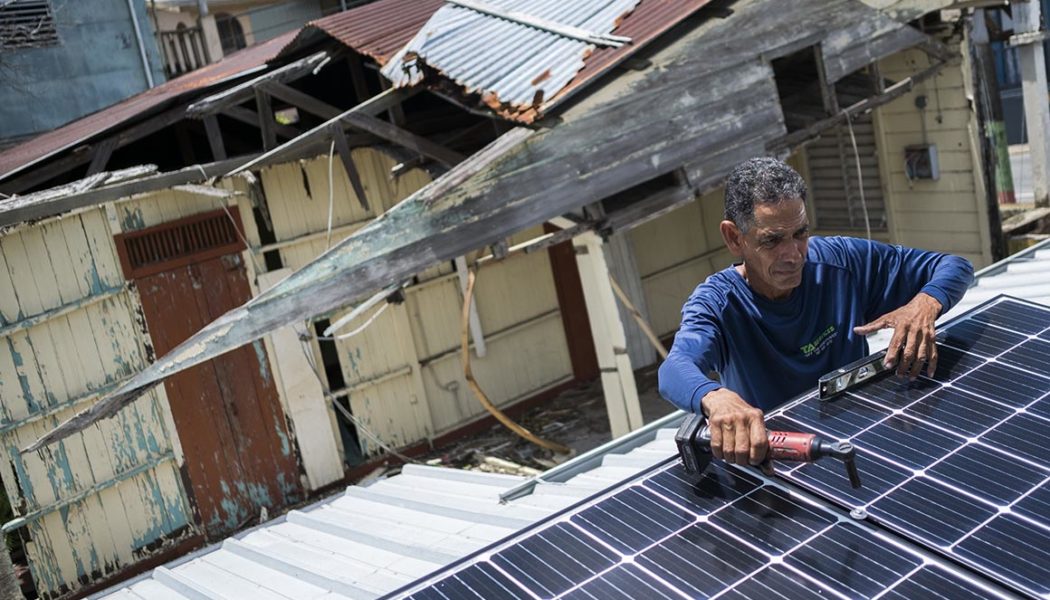
‘The grid is in need of complete replacement’
PREPA, which regularly put off grid maintenance because of financial shortfalls, will have a major voice in how the incoming FEMA funds are spent because it must put forth projects for the agency and its regulator to approve. The utility is under pressure from the Queremos Sol coalition and other organizations to shift its focus more toward renewables rather than rebuilding existing or developing new petroleum-based infrastructure.
The system has been in “severe decay” due to years of poor maintenance and further destabilized by the 2020 earthquake, said Luis Martinez, director of Southeast energy for the Natural Resources Defense Council’s climate and clean energy program.
“I think the grid is in need of complete replacement,” he said, adding that it was not designed to withstand the more powerful hurricanes that climate change will increasingly stir in the Atlantic. “Just the layout with generation in the South being sent to the San Juan area in the Northeast across the central mountain range … makes it very difficult and costly to repair and maintain.”
Plants that run on fuel oil or diesel still provided half the island’s power in 2020, while imported natural gas has seen its share reach 29 percent and coal generated 19 percent. Hydropower and other renewables provided only 2.5 percent.
Under the 2019 Puerto Rico Energy Public Policy Act (17-2019), PREPA is required to obtain 40 percent of its electricity from renewable resources by 2025, 60 percent by 2040 and 100 percent by 2050. The law also requires it to phase out coal-fired generation by 2028.
Those figures are roughly in line with Biden’s goal for the country and set a pace that climate advocates say should preclude further dependence on fossil fuels on the island.
“I do think Puerto Rico has the opportunity to go from a system based on petroleum, which is very antiquated in terms of generating electricity, to essentially a state-of-the-art distributed renewable-based system, which can then be a model for other states,” Martinez said. He advised against taking “that intermediate step that a lot of folks seem to be pushing for, which is to go to imported liquefied gas, which is even more expensive.”
But González-Colón dismissed those green ambitions as unfeasible for the immediate future, saying the island needs to take an “all-of-the-above” approach while the grid is being rebuilt to enable more renewables.
”We need to use LNG as a way to cut expenses and stabilize the system at the same time you are investing in renewable energy,” she said.
For LUMA, the problems are more immediate. Data the company supplied to the legislature show that its average power outage time more than doubled to five hours compared with less than half that time in 2020 since it took over the grid in June, according to a report in The New York Times, though CEO Wayne Stensby has said figures from previous years undercounted the outage time. Those service disruptions prompted a protest that closed a highway in San Juan in October.
The relationship between LUMA Energy and Puerto Rican legislators has also deteriorated to the point that a judge in Puerto Rico found Stensby in contempt of court and issued an arrest order on Nov. 10 for failing to provide requested documents, including those pertaining to executive salaries and the makeup and experience of its workforce. The judge later nullified the order after LUMA provided the documents.
The grid in Puerto Rico was already “in pretty bad shape” due to the deferred maintenance by PREPA, said Cathy Kunkel, energy program manager with Cambio PR, an organization promoting sustainable policies and strategies in Puerto Rico and the Caribbean. But “the LUMA privatization has certainly made things worse.”
Before joining Cambio, Kunkel was lead author of a report published in August by the Institute for Energy Economics and Financial Analysis that described significant issues with the LUMA Energy contract as well as damaging voltage fluctuations and poor customer service since the company took over the grid. The report attributed the problems to a lack of personnel, insufficient transparency and the absence of effective oversight.
Stensby, at an Oct. 6 hearing by the House Natural Resources Committee, blamed a union blockade for a slow start to repair work and observed that “PREPA is unquestionably the worst performing utility in the United States by each and every measure.”
“It took two decades for PREPA to get in this state, we shouldn’t forget, and that’s why it’s so important to get started and continue to push ahead,” he said. The company has since reached an agreement with the International Brotherhood of Electrical Workers, which will represent LUMA lineworkers, while the company will invest $10 million in a technical training program for those workers.
LUMA said it has made improvements in its first six months of managing the grid, such as upgrading more than 1,800 power poles and dozens of critical distribution breakers to reduce the likelihood of future outages.
“Any service interruption is one too many and we are working hard to make the service and infrastructure improvements so that customers see fewer interruptions,” the company said in a Dec. 3 statement.
LUMA said it has connected solar panels for 12,000 customers since June, amounting to 50 megawatts of renewable energy. In September, LUMA has also launched a map on its website to show customers and developers what areas could most easily accept solar projects. And the company said it’s on track to eliminate a backlog of solar connection requests by January.
Pushing ahead with fossil fuels
In the meantime, PREPA’s regulator authorized the utility to begin preliminary work for a new fossil fuel-powered unit or energy storage at the fuel-oil power plant Palo Seco to protect against near term price fluctuations of solar PV and battery energy storage and other potential reliability concerns. Environmental justice advocates have objected to the project because of the public health and other harms it could cause for nearby communities.
Environmental advocates are hoping with $9.4 billion in FEMA money flowing to Puerto Rico, the federal government will help tip the scales toward renewable power. But in August, the agency dashed their hopes by declaring that the power grid work in Puerto Rico would have no significant impact on the environment.
A coalition called the Alianza Energía Renovable Ahora, the Alliance for Renewable Energy Now, asked the agency in October to reconsider that finding. The coalition accused FEMA of bucking repeated instructions from Congress to direct funding away from infrastructure vulnerable to storms, failing to comply with National Environmental Policy Act’s mandates to consider all energy alternatives and their climate impacts, and failing to account for environmental justice.
In particular, the group says the agency should look at alternatives such as battery energy storage and rooftop solar.
A FEMA spokesperson said via email that it carefully reviews all requests and is evaluating this one.
But NRDC’s Martinez said FEMA could “put its foot down” and say the funding proposals must meet the Biden administration’s goals, requirements imposed by the Puerto Rico Energy Bureau and the island’s renewable energy legislative target.
“If they say that, I think that will clarify how much wiggle room the utility has to essentially go rogue,” he said. “They’re not following what the law says or what the regulators say.”
A PREPA spokesperson could not be reached for comment, but a FEMA spokesperson said via email that “while FEMA has no standing in the terms of the contract between PREPA and LUMA, FEMA has worked with the Government of Puerto Rico to maximize the flexibility of funding, including the ability to pursue renewable energy resources.”
But Queremos Sol’s Santiago said the island’s continuing power outages and its slow transition to solar power pose an environmental justice issue — one that the Biden administration has the power to address.
“What we’re seeing right now is that anyone who can afford to get rooftop solar and batteries is doing it. The problem is we don’t have a lot of people who can afford to do that on their own,” she said. “The way to get this solution in place — and everyone agrees it’s a solution to have rooftop solar and battery energy storage systems onsite — is to use those federal funds.”
[flexi-common-toolbar] [flexi-form class=”flexi_form_style” title=”Submit to Flexi” name=”my_form” ajax=”true”][flexi-form-tag type=”post_title” class=”fl-input” title=”Title” value=”” required=”true”][flexi-form-tag type=”category” title=”Select category”][flexi-form-tag type=”tag” title=”Insert tag”][flexi-form-tag type=”article” class=”fl-textarea” title=”Description” ][flexi-form-tag type=”file” title=”Select file” required=”true”][flexi-form-tag type=”submit” name=”submit” value=”Submit Now”] [/flexi-form]









